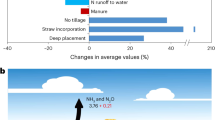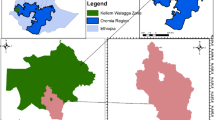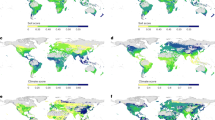Abstract
China’s cropland soil has faced acidification since the latter half of the twentieth century; however, the temporal and spatial variations of this are poorly known. Here we analyse cropland soil acidification using 7,024 regional surveys and a machine learning model to project spatiotemporal variations in cropland topsoil pH across China from 1985 to 2040. Our results reveal a turning point in China’s agricultural soil chemistry: consistent acidification from the 1980s ceased as a whole around 2013 (with a cumulative pH decline of ~0.25 units during 1985–2013), correlating strongly with changes in nitrogen fertilizer application patterns consequent to agricultural policy reforms. Regional heterogeneity was observed, with paddy fields exhibiting pH recovery post-2013 while values in dryland soils remained largely static since 2000. These findings underscore the critical role of agricultural policy and nitrogen fertilizer management in shaping soil health dynamics. This Article offers guidance for sustainable agriculture in China while providing insights applicable to global farming practices.
This is a preview of subscription content, access via your institution
Access options
Access Nature and 54 other Nature Portfolio journals
Get Nature+, our best-value online-access subscription
$32.99 / 30 days
cancel any time
Subscribe to this journal
Receive 12 print issues and online access
$259.00 per year
only $21.58 per issue
Buy this article
- Purchase on SpringerLink
- Instant access to full article PDF
Prices may be subject to local taxes which are calculated during checkout




Similar content being viewed by others
Data availability
All datasets analysed during this study are available in public repositories. Soil type, parent material and soil texture (sand, silt, and clay content) were acquired from the National Earth System Science Data Center (http://soil.geodata.cn and http://www.geodata.cn). Temperature, precipitation and PM10 data were sourced from the National Tibetan Plateau/Third Pole Environment Data Center (https://data.tpdc.ac.cn/home and https://doi.org/10.5281/zenodo.3752465). NHx-N and NOy-N deposition data were obtained from https://doi.org/10.1594/PANGAEA.942069 (ref. 55). Chemical N fertilizer consumption, rice yield, wheat yield and corn yield data originated from the China Statistical Yearbook (1981-2022), published by the National Bureau of Statistics of China (https://data.stats.gov.cn/publish.htm?sort=1). Land-use type data (https://geodata.pku.edu.cn/index.php?c=content&a=show&id=173) were derived from the China Multi-Period Land Use Land Cover Remote Sensing Monitoring Dataset (CNLUCC). The source data required to generate the figures in this study are available via figshare at https://doi.org/10.6084/m9.figshare.29108045.v2 (ref. 68). Data for the predictors can also be found in the Supplementary Information. Regional soil pH data are protected and are not available owing to data privacy laws.
Code availability
The codes for this study are available via Figshare at https://doi.org/10.6084/m9.figshare.29108045.v2 (ref. 68).
References
Tian, D. & Niu, S. A global analysis of soil acidification caused by nitrogen addition. Environ. Res. Lett. 10, 024019 (2015).
Sumner, M. E. & Noble, A. D. in Handbook of Soil Acidity (ed. Rengel, Zdenko) 15–42 (CRC Press, 2003).
Bronick, C. J. & Lal, R. Soil structure and management: a review. Geoderma 124, 3–22 (2005).
Raza, S. et al. Inorganic carbon losses by soil acidification jeopardize global efforts on carbon sequestration and climate change mitigation. J. Clean. Prod. 315, 128036 (2021).
Guo, J. H. et al. Significant acidification in major chinese croplands. Science 327, 1008–1010 (2010).
Malik, A. A. et al. Land use driven change in soil pH affects microbial carbon cycling processes. Nat. Commun. 9, 3591 (2018).
Smith, P. et al. Global change pressures on soils from land use and management. Glob. Change Biol. 22, 1008–1028 (2016).
Circular of the State Council on Conducting the Third National Soil Census (Chinese State Council, 2022); https://www.gov.cn/gongbao/content/2022/content_5678068.htm
Lie, Z. et al. Acidity of soil and water decreases in acid-sensitive forests of tropical China. Environ. Sci. Technol. 57, 11075–11083 (2023).
Su, C. et al. Interannual and seasonal variabilities in soil NO fluxes from a rainfed maize field in the Northeast China. Environ. Pollut. 286, 117312 (2021).
Xu, D. et al. Major drivers of soil acidification over 30 years differ in paddy and upland soils in China. Sci. Total Environ. 916, 170189 (2024).
Yang, Y. et al. Significant soil acidification across northern China’s grasslands during 1980s–2000s. Glob. Change Biol. 18, 2292–2300 (2012).
Posch, M. & Reinds, G. J. A very simple dynamic soil acidification model for scenario analyses and target load calculations. Environ. Model. Softw. 24, 329–340 (2009).
Zeng, M. et al. Model-based analysis of the long-term effects of fertilization management on cropland soil acidification. Environ. Sci. Technol. 51, 3843–3851 (2017).
Hengl, T. et al. SoilGrids250m: global gridded soil information based on machine learning. PLoS One 12, e0169748 (2017).
Nachtergaele, F. et al. Harmonized World Soil Database Version 2.0 (FAO, accessed 1 November, 2024); https://www.fao.org/soils-portal/data-hub/soil-maps-and-databases/harmonized-world-soil-database-v20/en/
Song, X.-D. et al. Significant loss of soil inorganic carbon at the continental scale. Natl Sci. Rev. 9, nwab120 (2022).
Li, H. et al. Decipher soil organic carbon dynamics and driving forces across China using machine learning. Glob. Change Biol. 28, 3394–3410 (2022).
Page, A., Miller, R. & Keeney, D. Methods of Soil Analysis, Part II (American Society of Agronomy, 1982).
Agricultural Industry Standard (NY/T 1377-2007) (Ministry of Agriculture and Rural Affairs of the People’s Republic of China, 2007).
Han, Y., Yi, D., Ye, Y., Guo, X. & Liu, S. Response of spatiotemporal variability in soil pH and associated influencing factors to land use change in a red soil hilly region in southern China. Catena 212, 106074 (2022).
Awadelkareem, W., Haroun, M., Wang, J. & Qian, X. Nitrogen interactions cause soil degradation in greenhouses: their relationship to soil preservation in China. Horticulturae 9, 340 (2023).
Liu, L., Wen, Z., Liu, S., Zhang, X. & Liu, X. Decline in atmospheric nitrogen deposition in China between 2010 and 2020. Nat. Geosci. 17, 733–736 (2024).
Tang, C. & Rengel, Z. in Handbook of Soil Acidity (ed. Rengel, Zdenko) 71–96 (CRC Press, 2003).
He, H., Peng, M., Lu, W., Hou, Z. & Li, J. Commercial organic fertilizer substitution increases wheat yield by improving soil quality. Sci. Total Environ. 851, 158132 (2022).
Tessema, N., Yadeta, D., Kebede, A. & Ayele, G. T. Soil and irrigation water salinity, and its consequences for agriculture in Ethiopia: a systematic review. Agriculture 13, 109 (2022).
Hao, T. et al. Impacts of nitrogen fertilizer type and application rate on soil acidification rate under a wheat-maize double cropping system. J. Environ. Manag. 270, 110888 (2020).
Koo, B. J., Adriano, D. C., Bolan, N. S. & Barton, C. D. in Encyclopedia of Soils in the Environment (ed. Hillel, D.) 421–428 (Elsevier, 2005).
Fageria, N. & Baligar, V. Ameliorating soil acidity of tropical Oxisols by liming for sustainable crop production. Adv. Agron. 99, 345–399 (2008).
Ding, C. et al. Changes in the pH of paddy soils after flooding and drainage: modeling and validation. Geoderma 337, 511–513 (2019).
Kögel-Knabner, I. et al. Biogeochemistry of paddy soils. Geoderma 157, 1–14 (2010).
Tao, Y. et al. The characteristics of soil salinization effects on nitrogen mineralization and nitrification in upland fields. Front. Environ. Sci. 12, 1369554 (2024).
Li, S., Wang, Z., Hu, T., Gao, Y. & Stewart, B. Nitrogen in dryland soils of China and its management. Adv. Agron. 101, 123–181 (2009).
Rengel, Z. in Soil Health and Climate Change (eds Bhupinder Pal Singh, B. P. et al.) 69–85 (Springer, 2011).
Helyar, K. R. & Porter, W. Soil acidification, its measurement and the processes involved. in Soil Acidity and Plant Growth (ed. Brady, N. C.) 61–101 (Academic Press, 1989).
Goulding, K. Soil acidification and the importance of liming agricultural soils with particular reference to the United Kingdom. Soil Use Manag. 32, 390–399 (2016).
Zhang, Y. et al. Characterization of soil salinization and its driving factors in a typical irrigation area of Northwest China. Sci. Total Environ. 837, 155808 (2022).
Wang, C. et al. Impact of 25 years of inorganic fertilization on diazotrophic abundance and community structure in an acidic soil in southern China. Soil Biol. Biochem. 113, 240–249 (2017).
Wang, J., He, T. & Lin, Y. Changes in ecological, agricultural, and urban land space in 1984–2012 in China: land policies and regional social-economical drivers. Habitat Int. 71, 1–13 (2018).
Zhou, F. & Wen, C. Research on the level of agricultural green development, regional disparities, and dynamic distribution evolution in China from the perspective of sustainable development. Agriculture 13, 1441 (2023).
Shi, R.-y. et al. Mechanisms for increasing the pH buffering capacity of an acidic Ultisol by crop residue-derived biochars. J. Agric. Food Chem. 65, 8111–8119 (2017).
Xin-zhu, L. et al. Characteristics of soil organic carbon components and their correlation with other soil physical and chemical factors in cotton fields with different continuous cropping years in the oasis on the northern edge of Tarim Basin. Environ. Sci. 43, 4639–4647 (2022).
Han, L. et al. Nitrogen addition affects ecosystem carbon exchange by regulating plant community assembly and altering soil properties in an alpine meadow on the Qinghai–Tibetan plateau. Front. Plant Sci. 13, 900722 (2022).
Yang, F. et al. Evolution of loess-derived soil along a climatic toposequence in the Qilian Mountains, NE Tibetan Plateau. Eur. J. Soil Sci. 68, 270–280 (2017).
Ma, Y.-J., Xie, T. & Li, X.-Y. Spatial variation of soil organic carbon in the Qinghai Lake watershed, northeast Qinghai–Tibet Plateau. Catena 213, 106187 (2022).
Zhaofeng, W., Hartemink, A. E., Zhang, Y., Zhang, H. & Mingjun, D. Major elements in soils along a 2.8-km altitudinal gradient on the Tibetan Plateau. China Pedosphere 26, 895–903 (2016).
Luo, W. et al. Contrasting pH buffering patterns in neutral-alkaline soils along a 3600 km transect in northern China. Biogeosciences 12, 7047–7056 (2015).
Wang, Z. et al. Forms of nitrogen inputs regulate the intensity of soil acidification. Glob. Change Biol. 29, 4044–4055 (2023).
Lal, R. Restoring soil quality to mitigate soil degradation. Sustainability 7, 5875–5895 (2015).
Yan, P. et al. Soil acidification in Chinese tea plantations. Sci. Total Environ. 715, 136963 (2020).
Ma, J. F., Ryan, P. R. & Delhaize, E. Aluminium tolerance in plants and the complexing role of organic acids. Trends Plant Sci. 6, 273–278 (2001).
Huang, J. & Hartemink, A. E. Soil and environmental issues in sandy soils. Earth-Sci. Rev. 208, 103295 (2020).
Anderson, D. The effect of parent material and soil development on nutrient cycling in temperate ecosystems. Biogeochemistry 5, 71–97 (1988).
Liu, Y. et al. Regional variation in the temperature sensitivity of soil organic matter decomposition in China’s forests and grasslands. Glob. Change Biol. 23, 3393–3402 (2017).
Tian, H. et al. HaNi: a Historical dataset of Anthropogenic Nitrogen Inputs to the terrestrial biosphere (1860–2019). PANGAEA https://doi.org/10.1594/PANGAEA.942069 (2022).
Cui, Z. et al. Pursuing sustainable productivity with millions of smallholder farmers. Nature 555, 363–366 (2018).
Zhalnina, K. et al. Dynamic root exudate chemistry and microbial substrate preferences drive patterns in rhizosphere microbial community assembly. Nature Microbiol. 3, 470–480 (2018).
Cutler et al. Random forests for classification in ecology. Ecology 88, 2783–2792 (2007).
Breiman, L. Random forests. Mach. Learn. 45, 5–32 (2001).
Johnson, R. W. An introduction to the bootstrap. Teach. Stat. 23, 49–54 (2001).
Ho, T. K. The random subspace method for constructing decision forests. IEEE Trans. Pattern Anal. Mach. Intell. 20, 832–844 (1998).
Díaz-Uriarte, R. & Andrés, S. A. D. Gene selection and classification of microarray data using random forest. BMC Bioinform. 7, 3 (2006).
Strobl, C., Boulesteix, A.-L., Zeileis, A. & Hothorn, T. Bias in random forest variable importance measures: Illustrations, sources and a solution. BMC Bioinform. 8, 25 (2007).
Svetnik, V. et al. Random forest: a classification and regression tool for compound classification and QSAR modeling. J. Chem. Inf. Comput. Sci. 43, 1947–1958 (2003).
Hothorn, T. & Lausen, B. Double-bagging: combining classifiers by bootstrap aggregation. Pattern Recognit. 36, 1303–1309 (2003).
James, G., Witten, D., Hastie, T. & Tibshirani, R. An Introduction to Statistical Learning Vol. 112 (Springer, 2013).
IPCC Climate Change 2021: The Physical Science Basis. (eds V. Masson-Delmotte, V. et al.) (Cambridge Univ. Press, 2021).
Zhang, W. et al. The data and code of “Stabilisation of Acidification in China’s Cropland Soils”. figshare https://doi.org/10.6084/m9.figshare.29108045.v2 (2025).
Acknowledgements
We thank the many providers of data, which were an essential component of this work, and undergraduate students from NingboTech University and Yangtze University for collecting the data. We acknowledge the National Tibetan Plateau Data Center (TPDC) and the National Earth System Science Data Center (https://www.geodata.cn) for data support. This work is supported by the National Key Research and Development Program of China (nos. 2020YFC1807002 and 2021YFC1809103 to Y.Y., 2022YFD1700104 to Y. Luo and 2022YFD1900604 to J.L.) and the National Natural Science Foundation of China (nos. 42077140 to Y.Y., 41991335 to Y. Luo and 42177300 to J.L.).
Author information
Authors and Affiliations
Contributions
Y.Y. conceived the idea. Y.Y. and Y. Luo designed the study. W.Z, Y. Li and Y.H collected the data. W.Z., C.W., J.L., J.M. and Y.Z. analysed the data. Y.Y., W.Z. and Q.Z. performed the modelling. Y.Y., W.Z., C.W., J.L. and Q.Z. wrote the first complete draft of the paper. Y.Y., W.Z. and Q.Z. revised the paper, with inputs from all co-authors. All authors contributed to the interpretation of results, writing and revision of the paper.
Corresponding authors
Ethics declarations
Competing interests
The authors declare no competing interests.
Peer review
Peer review information
Nature Geoscience thanks the anonymous reviewer(s) for their contribution to the peer review of this work. Primary Handling Editors: Alison Hunt and Xujia Jiang, in collaboration with the Nature Geoscience team.
Additional information
Publisher’s note Springer Nature remains neutral with regard to jurisdictional claims in published maps and institutional affiliations.
Supplementary information
Supplementary Information
Supplementary Figs. 1–15, Tables 1–3 and references.
Rights and permissions
Springer Nature or its licensor (e.g. a society or other partner) holds exclusive rights to this article under a publishing agreement with the author(s) or other rightsholder(s); author self-archiving of the accepted manuscript version of this article is solely governed by the terms of such publishing agreement and applicable law.
About this article
Cite this article
Zhang, W., Wei, C., Li, J. et al. Stabilization of acidification in China’s cropland soils. Nat. Geosci. (2025). https://doi.org/10.1038/s41561-025-01813-1
Received:
Accepted:
Published:
DOI: https://doi.org/10.1038/s41561-025-01813-1



